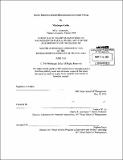System dynamics, market microstructure and asset pricing
Author(s)
Leika, Mindaugas
DownloadFull printable version (9.963Mb)
Other Contributors
Sloan School of Management.
Advisor
Andrew W. Lo.
Terms of use
Metadata
Show full item recordAbstract
Traditional asset pricing approaches are not able to explain extreme volatility and tail events that characterized financial markets in the past decade. System Dynamics theory, which is still underutilized in financial modeling, could help researchers to model stock market dynamics, explain and simulate extreme events. This paper proposes an artificial stock market model, which can be used to simulate stock market behavior, incorporate various assumptions about interactions among market participants: fundamental, noise and technical traders. The model includes multiple feedback loops, namely, positive feedback, ratings, debt and leverage. Dynamic interactions among loops stabilize markets and limit bubble formation. Model simulation results show, that not only the numerical limit of leverage, but also regulatory definition of leverage matters. Market stability can be achieved faster with lower system-wide and narrow definition of leverage. To increase stability, Central banks and regulators might consider targeting leverage in a financial system.
Description
Thesis (M.B.A.)--Massachusetts Institute of Technology, Sloan School of Management, 2013. Cataloged from PDF version of thesis. Includes bibliographical references (p. 57-59).
Date issued
2013Department
Sloan School of ManagementPublisher
Massachusetts Institute of Technology
Keywords
Sloan School of Management.